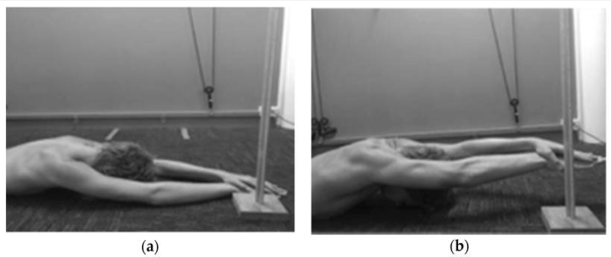Combined Elevation Test
Introduction and Purpose[edit | edit source]
The Combined Elevation Test (CET) is a musculoskeletal screening technique originally developed by Blanch that involves a synchronized movement of thoracic extension, glenohumeral joint (GHJ) flexion, scapula retraction and upward rotation.[1][2] It replicates the streamline position in swimming required to reduce drag force and is commonly used to assess:
- upper extremity and upper back strength
- shoulder (glenohumeral joint and scapulo-thoracic joint) and thoracic spine flexibility. [3]
It has been widely used as an assessment tool in various sports other than swimming such as cricket, rugby union, triathlon and surf lifesaving.[3]
Sport-specific musculoskeletal screening techniques (MSTs) are used in:
- the identification of intrinsic risk factors for injury
- determining whether a patient can achieve a minimum standard for participation in a particular sport and
- to assist in appropriate goal setting for performance enhancement.[1][4]
Technique[edit | edit source]
Equipment required:[edit | edit source]
A measuring stand with a 1 mm incremental scale or a measuring tape.[3]
Procedure:[edit | edit source]

- Participants are required to lie prone on the floor and assume a streamline swimming position. The forehead, chest, hips, knees and feet are on the floor( Figure a). Forehead contact with the floor is used as opposed to chin contact.[3][5]
- The participant should assume a posture with the left hand on top of the right hand: elbows, wrists and palms straight and fully extended. Participants are required to hold a neutral wrist position, determined by the position of the metacarpals in relation to the ulna. Measurements are only taken when the patient’s metacarpals is aligned with the ulna in the sagittal plane.
- Participants are then instructed to maximally raise their arms away from the floor, while their forehead, chest, pelvis, and feet maintain contact with the floor( Figure b). The perpendicular distance between the base of the metacarpo-phalangeal joint (MCPJ) of the third finger and the floor is then measured.The height of the base of the measuring stand should be added to each measure taken.
- Three sub-maximal attempts should be performed as a warm up to familiarize the participants with the movement required. Following the warm up, each participant perform three maximal efforts of the CET. A rest period of 10 s between each performance is given and measurements are then collected.[3]
Alternate procedure:[edit | edit source]
Dennis et al (2008) describe an alternate way of performing the test with good reliability.[7]
- The participant lies prone on the floor with both arms outstretched above his/her head.
- Elbows are extended, thumbs locked and palms facing down.
- The participant is instructed to keep his/her feet, chin, chest and hips on the ground at all times.
- The participant is instructed to breath in, hold his/her breath and then raise both arms of the floor as high as possible, maintaining extension of the elbow.
- Measurement is taken from the base of the metacarpal of the thumb to the floor in a perpendicular line.
Evidence[edit | edit source]
Normative value[edit | edit source]
According to Blanch (2004), an appropriate range for the combined elevation test is between 5° and 15°, where the angle measured is the angle between the line of the humerus and the horizontal.[1]
Based on the study done by Furness et al. (2018) in age groups ranging from 8 to 18 years old, the overall average CET score for male and female were 19.38 +/-7.53cm and 20.09+/- 7.89cm respectively.[4]
Psychometric properties[edit | edit source]
Dennis et al. (2008) showed good intra- and inter-rater reliability when using the CET (ICC 0.89 and 0.97, respectively) among 10 cricket players.[7]
Furness et al. (2018) showed excellent intra-rater with an Intra-class Coefficient Correlation (ICC) of 0.991 with 416 participants (swimmers and non- swimmers).[4]
References[edit | edit source]
- ↑ 1.0 1.1 1.2 Blanch P. Conservative management of shoulder pain in swimming. Physical Therapy in Sport. 2004 Aug 1;5(3):109-24.
- ↑ 2.0 2.1 Furness J, Schram B, Corea D, Turner Z, Cairns H. The Combined Elevation Test (CET) in Adolescent School Children: A Pilot Study. Sports. 2018 Sep;6(3):64.
- ↑ 3.0 3.1 3.2 3.3 3.4 Furness J, Schram B, Corea D, Turner Z, Cairns H. The Combined Elevation Test (CET) in Adolescent School Children: A Pilot Study. Sports. 2018 Sep;6(3):64.
- ↑ 4.0 4.1 4.2 Furness J, Schram B, Corea D, Turner Z, Cairns H. Normative Data Collection of the Combined Elevation Test (CET) in Swimmers and Non-Swimmers.
- ↑ Allen S, Phillips G, McCaig S. A biomechanical evaluation of the combined elevation test. Physical Therapy in Sport. 2017 May 1;25:1-8.
- ↑ Health and high performance. Combined elevation test for shoulder strength and mobility. Available from: https://www.youtube.com/watch?v=6R1XIODti9E [last assessed: 2019/12/24]
- ↑ 7.0 7.1 Dennis RJ, Finch CF, Elliott BC, Farhart PJ. The reliability of musculoskeletal screening tests used in cricket. Physical Therapy in Sport. 2008 Feb 1;9(1):25-33.






